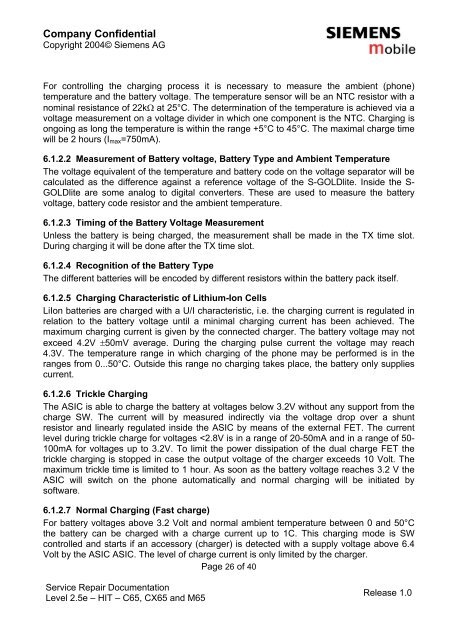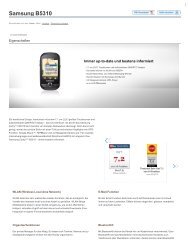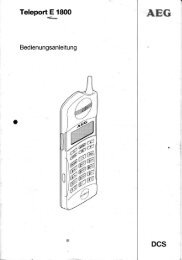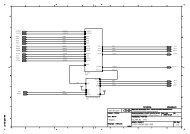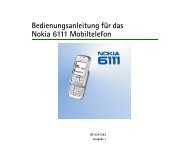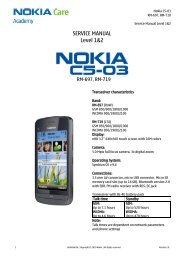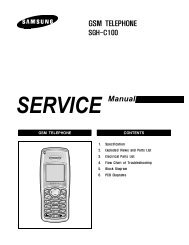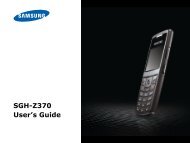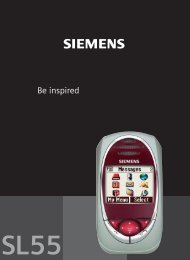Service Repair Documentation Level 2.5e – HIT ... - Altehandys.de
Service Repair Documentation Level 2.5e – HIT ... - Altehandys.de
Service Repair Documentation Level 2.5e – HIT ... - Altehandys.de
Create successful ePaper yourself
Turn your PDF publications into a flip-book with our unique Google optimized e-Paper software.
Company Confi<strong>de</strong>ntial<br />
Copyright 2004© Siemens AG<br />
For controlling the charging process it is necessary to measure the ambient (phone)<br />
temperature and the battery voltage. The temperature sensor will be an NTC resistor with a<br />
nominal resistance of 22kΩ at 25°C. The <strong>de</strong>termination of the temperature is achieved via a<br />
voltage measurement on a voltage divi<strong>de</strong>r in which one component is the NTC. Charging is<br />
ongoing as long the temperature is within the range +5°C to 45°C. The maximal charge time<br />
will be 2 hours (Imax=750mA).<br />
6.1.2.2 Measurement of Battery voltage, Battery Type and Ambient Temperature<br />
The voltage equivalent of the temperature and battery co<strong>de</strong> on the voltage separator will be<br />
calculated as the difference against a reference voltage of the S-GOLDlite. Insi<strong>de</strong> the S-<br />
GOLDlite are some analog to digital converters. These are used to measure the battery<br />
voltage, battery co<strong>de</strong> resistor and the ambient temperature.<br />
6.1.2.3 Timing of the Battery Voltage Measurement<br />
Unless the battery is being charged, the measurement shall be ma<strong>de</strong> in the TX time slot.<br />
During charging it will be done after the TX time slot.<br />
6.1.2.4 Recognition of the Battery Type<br />
The different batteries will be enco<strong>de</strong>d by different resistors within the battery pack itself.<br />
6.1.2.5 Charging Characteristic of Lithium-Ion Cells<br />
LiIon batteries are charged with a U/I characteristic, i.e. the charging current is regulated in<br />
relation to the battery voltage until a minimal charging current has been achieved. The<br />
maximum charging current is given by the connected charger. The battery voltage may not<br />
exceed 4.2V ±50mV average. During the charging pulse current the voltage may reach<br />
4.3V. The temperature range in which charging of the phone may be performed is in the<br />
ranges from 0...50°C. Outsi<strong>de</strong> this range no charging takes place, the battery only supplies<br />
current.<br />
6.1.2.6 Trickle Charging<br />
The ASIC is able to charge the battery at voltages below 3.2V without any support from the<br />
charge SW. The current will by measured indirectly via the voltage drop over a shunt<br />
resistor and linearly regulated insi<strong>de</strong> the ASIC by means of the external FET. The current<br />
level during trickle charge for voltages


